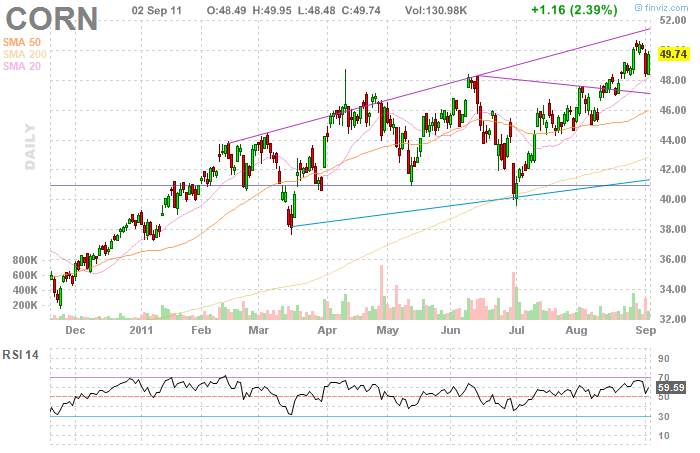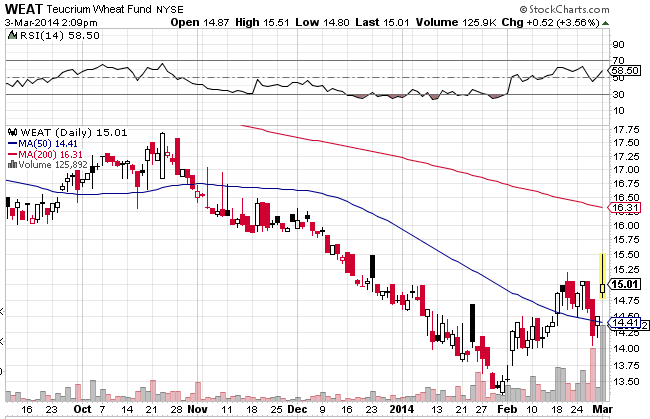Bushels Of Speculation In The Teucrium Corn Fund Teucrium Corn ETF (NYSEARCA CORN)
Post on: 29 Июль, 2015 No Comment

By Abraham Bailin
In the Midwest, we are in the midst of the worst drought in over 50 years. It’s hard to complain about heat here in Chicago, but the breadbasket of the world is taking a real hit. Persistent and extreme hot and dry conditions have prompted the USDA to make successive cuts to crop projections over the past several weeks. The current projection cuts sit in the midteens. That figure marks a significantly larger supply shock than had been expected. Not surprisingly, corn prices have skyrocketed. September corn futures are up over 50% from mid-June with later-month contracts following suit.
The fallout of the aridity hasn’t been relegated to the corn markets. Wheat and beans have seen substantial positive price performance. Front-month wheat has jumped to over $9 per bushel from roughly $6.30 a month ago. Over the same period, soybeans jumped to $16.80 from $13.80.
It is noteworthy that, even with the projection cuts for the corn crop, this harvest is still set to be one of the largest on the record. Corn prices could fall once harvest time comes. That said, weather reports don’t show signs of relief. Across the Midwest, arid weather is due to continue with negligible amounts of rain expected for at least the next week or so. All this makes for continued strong price pressure for corn and has paid off for the Teucrium Corn Fund (NYSEARCA:CORN ). Individual commodities are notoriously volatile, so an investment in CORN is only for a speculative investor willing to actively manage their allocation.
Generally speaking, investors hold agriculture commodities in their portfolio for three reasons. First is diversification: Agriculture commodities have historically had low correlations to stocks and bonds, which suggests that this asset class would serve well as a portfolio diversifier. Second, commodities can be used as a hedge against inflation. Our research suggests that within a diversified portfolio, a 4%-10% weight in commodities, which would include primarily energy, agriculture, industrial metals, and precious metals, is sufficient. The final reason to own a commodity fund is for outright price speculation. This is where CORN shines.
CORN provides exposure to only one agriculture commodity—its namesake—whose price moves have been supercharged by the drought. Given the level of specificity CORN affords investors, we believe this fund serves well as a price-speculation vehicle.
Like most commodity funds, CORN invests in futures contracts and does not hold physical assets. The fund invests about a third of its assets in three different corn futures contracts that trade on the Chicago Board of Trade: (1) the second-to-expire CBOT Corn Futures Contract (which accounts for 35% of the portfolio), (2) the third-to-expire CBOT Corn Futures Contract (30%), and (3) the CBOT Corn Futures Contract expiring in the December following the expiration month of the third-to-expire contract (35%). The fund will basically mimic the benchmark but is also authorized to invest in other corn derivatives as well, should it hit CFTC position limits. Corn futures contracts traded on the CBOT expire on a specific day in five different months a year; as a result, this fund will roll its positions around those five dates. The fund sponsors will roll the fund’s contracts over a period of several days to minimize market movements and to limit third parties from profiting from its roll activity. Since the corn futures contracts expire on a specific day in March, May, July, September, and December, the fund will roll its contracts five times a year; but because of its structure, it will roll only about a third of its contracts at a time. This structure can reduce, but it won’t eliminate, the effects of contango or backwardation.
This fund is structured as a partnership, so shareholders will receive K-1 forms (instead of 1099 forms), which inform shareholders of their pro-rated share of the fund’s gains and losses from the purchase and sale of futures contracts. If there is a gain, shareholders will incur a tax liability, under which 60% of the gains will be taxed at the long-term capital gains tax rate, and the remaining 40% will be taxed at short-term rates at the end of every year, regardless of shareholders’ holding period. If the fund generated losses, the shareholders’ share of tax losses may be used to offset other income. Upon sale of shares, the investors’ cost basis will be adjusted to reflect gains or losses already reported and will be liable for capital gains taxes.

Investors in this ETF should have some understanding of the main drivers of corn prices, including public policy regarding ethanol and global corn harvest forecasts.
The expense ratio for this fund is 1.71%, which is significantly higher than other agriculture commodity funds. However, this is the only fund that provides specific exposure to corn.
Investors can get exposure to corn futures through broader agriculture commodity funds. PowerShares DB Agriculture (NYSEARCA:DBA ) is the largest and most liquid fund in its category. This fund’s top holdings are corn, cattle, beans, and sugar, each of which account for 10%-17% of the portfolio. The expense ratio for this fund is 1.01%.
ELEMENTS Rogers International Commodity Agricultural ETN (NYSEARCA:RJA ) is also a fairly liquid choice. The fund is an exchange-traded note, which has both advantages and disadvantages. The advantage is the tax treatment of ETNs—investors realize capital gains and losses only upon the sale of the ETN. The disadvantage is that this note is a debt security, which exposes investors to credit risk. Top holdings include wheat (which accounts for 14% of the portfolio), corn (14%), and cotton (12%). The expense ratio for this fund is 0.75%.
Disclosure: Morningstar licenses its indexes to certain ETF and ETN providers, including BlackRock, Invesco, Merrill Lynch, Northern Trust, and Scottrade for use in exchange-traded funds and notes. These ETFs and ETNs are not sponsored, issued, or sold by Morningstar. Morningstar does not make any representation regarding the advisability of investing in ETFs or ETNs that are based on Morningstar indexes.














